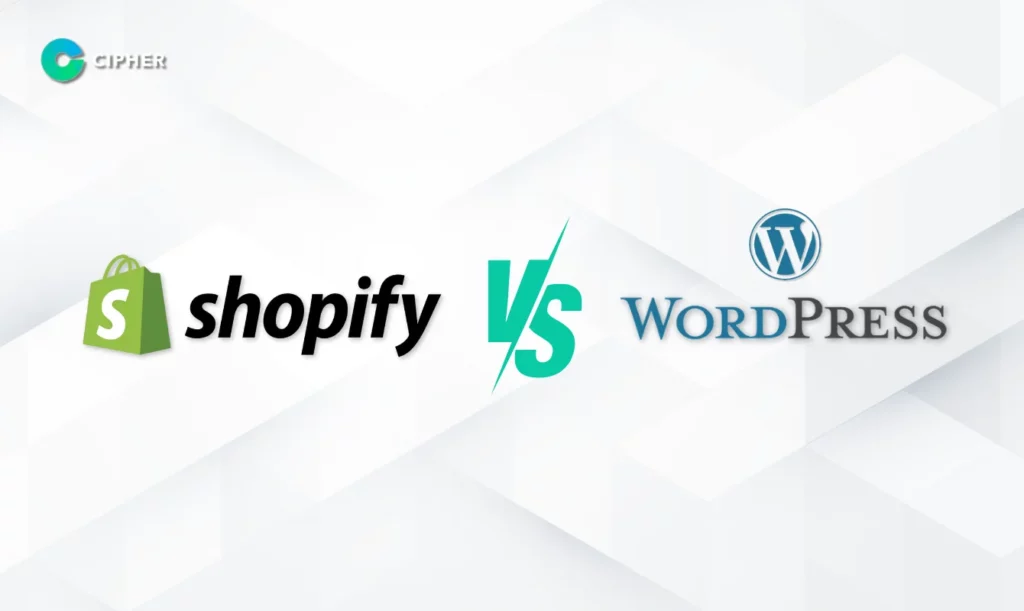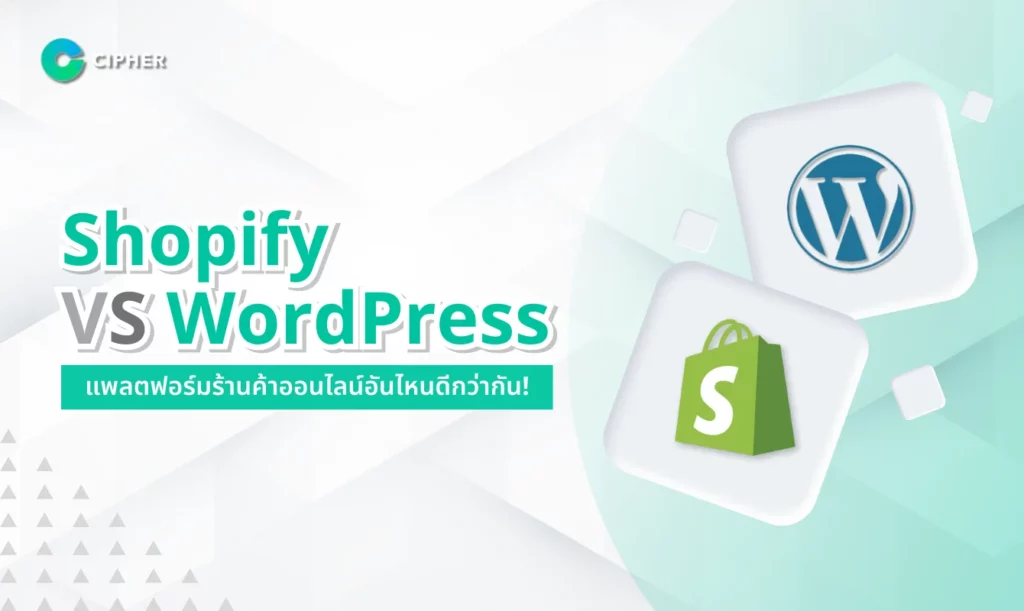Table of Contents
Shopify vs WordPress, which online store platform is better!
In the fast growing era of e-commerce, choosing the right platform for an online store is important. Many people may be making a decision between Shopify vs WordPress, the two most popular choices. This article compares the advantages and disadvantages of both platforms to answer the question, Shopify or WordPress is better for you.
Compare Shopify vs WordPress Highlights and Limitations

When it comes to comparisons between Shopify and WordPress, the first thing to understand is the distinctive features and limitations of each platform.
Shopify's highlights for online stores
Shopify is a platform designed specifically for online shopping, making it ideal for sales, basket, payment, delivery or store template design. Shopify is integrated, integrated, SSL-hosted, and easy to use through a user-friendly interface.
WordPress's ability to make sales sites.
WordPress is not built for direct online shopping, but can be done with a plug-in like WooCommerce. WordPress’ advantages are its unlimited flexibility, design and functionality, and many free plug-ins to choose from. However, WordPress is more complex. It must install and manage the host system itself, and it must always update the plug-in for security.
To better visualize the differences, let’s take a look at the key points that novices should know about Differences Between Word Press and Shopify.
Differences between WordPress and Shopify ที่มือใหม่ต้องรู้
- Shopify is available on a monthly basis, while WordPress is free, but the hosting domain itself is charged.
- Shopify is an all-in-one system. WordPress requires that you install additional plug-ins.
- Shopify is easier to use and WordPress is more deeply customizable.
- Shopify supports the creation of a specialized web site. WordPress fits all types of web sites.
Which platform should WooCommerce vs Shopify choose?

When it comes to WordPress, many people think of WooCommerce, the popular e-commerce plug-in that transforms WordPress into a full-fledged online store. Let’s find out which platform is more interesting.
Advantages of WooCommerce for Online Stores
- It’s a free plug-in, so the owner doesn’t have to pay monthly fees.
- Design and customize the store freely, including templates, functions, and other systems.
- There are many free plug-ins that enhance the store’s capabilities almost endlessly.
- Easily connect to other business platforms or services
Shopify Platform Highlights
- It was developed to be an online store platform exclusively with full features from beginning to end.
- Easy to use, no knowledge of programming, fast web.
- A paid monthly package that includes SSL hosting and domain values is available.
- There is a 24-hour support team that provides consulting and problem resolution.
- Support for POS systems that link stock and storefront sales.
compare costs and expenses
- Shopify starts at $29 per month, but there is an additional fee when using a payment gateway other than Shopify Payments.
- WordPress is free of charge for hosting, SSL domain and some plug-ins on an annual basis, which, if selected, may be higher than Shopify.
Shopify to WordPress Migration Guide
If you’re using Shopify, but plan to move to WordPress in the future, don’t worry because it’s not difficult to move data. Just follow these steps.
Product Data Migration Procedure
- Export the product information from Shopify to a CSV file.
- Create a store in WordPress through the WooCommerce plug-in.
- Import the CSV file into WooCommerce using the Product CSV Import Suite plug-in.
Initial WooCommerce settings
- Select a theme that supports WooCommerce and install it.
- set a method of payment, delivery, tax, &c.
- Adjust storefront with widgets and shot codes
How to Import Customer and Order Data
- Export customer information from Shopify into a CSV file and import it into WordPress using the Import Users from CSV plug-in.
- Order data cannot be imported directly. We recommend that you gradually enter the hand.
WordPress Compare: Theme Selection Techniques and Plug-ins
If you choose WordPress to create a store, choosing a good theme and plug-in will make your store more efficient and interesting.
Choosing the right theme for the store
- The theme should support WooCommerce specifically.
- Beautiful design to meet the target audience.
- It’s easy to adjust the composition.
- There is a free version available to experiment with.
- Choose from trusted developers with good results.
The plug-in is required for online stores.
- It supports a variety of online payments such as PayPal, Stripes.
- Manage shipping costs, such as Table Rate Shipping.
- Basket systems such as Yith WooCommerce Wishlist
- Add a Conversion Rate plugin like the Checkout Field Editor.
- Additional SEO plug-ins, such as Yoast SEO
In addition to choosing the right theme and plug-in, customizing the storefront to suit customers has helped boost sales significantly.
Interesting technique for remodeling a storefront.
- Use high-quality pictures, take them by yourself, or buy them from stock sources.
- Simplify layout, focus on product details.
- Choose colors to match brands and product styles.
- Design Banner Promotion to look attractive, such as discounted, free shipping.
- Categorize products clearly. Easy to find.
Summary
By comparing Shopify vs WordPress in different ways, it can be inferred that the two platforms have different advantages and disadvantages, which are suitable for online stores in different ways.
Shopify is a comprehensive and easy-to-use option for beginners who want to start selling online quickly without having to worry about code and background management, but there are few restrictions on customization for those who want to sell e-commerce via their own channel.
WordPress is a much more open and flexible platform that can be configured and installed independently. It is ideal for stores that require a variety of features or specialized customizations, but it requires more technical knowledge and self-managing.
Frequently Asked Questions (FAQs)
Shopify or WordPress for beginners?
Shopify is better suited for beginners because it’s easy to use and doesn’t require any coding or installation knowledge. In just a few clicks, there’s already an online store. WordPress is more customizable, but it takes more time to learn and manage the background systems.
How much is the initial cost of each platform?
Shopify plans to start at $29 per month, including SSL hosting and domain. WordPress is free, but you have to purchase the hosting and domain itself. The price is approximately Bt1,000 – 10,000 per year, depending on the quality of the hosting.
What kind of payment system does it support?
Shopify has a built-in Shopify Payments system that supports all types of credit/debit cards, including Apple Pay, Google Pay. WordPress supports plug-in payment methods such as Tripe, PayPal, 2C2P, etc.
Migrate data between two platforms?
Product information can be migrated from Shopify to WordPress by exporting the information to CSV and importing WooCommerce. Customers can import the information through the plug-in. However, the order data may need to be manually entered because the format between the two platforms is different.
How often do I need to update the system?
WordPress recommends updating the plug-in regularly at least 2-3 months at a time to close vulnerabilities and increase productivity. Shopify automatically updates features and security without requiring users to do so. Anything more?





